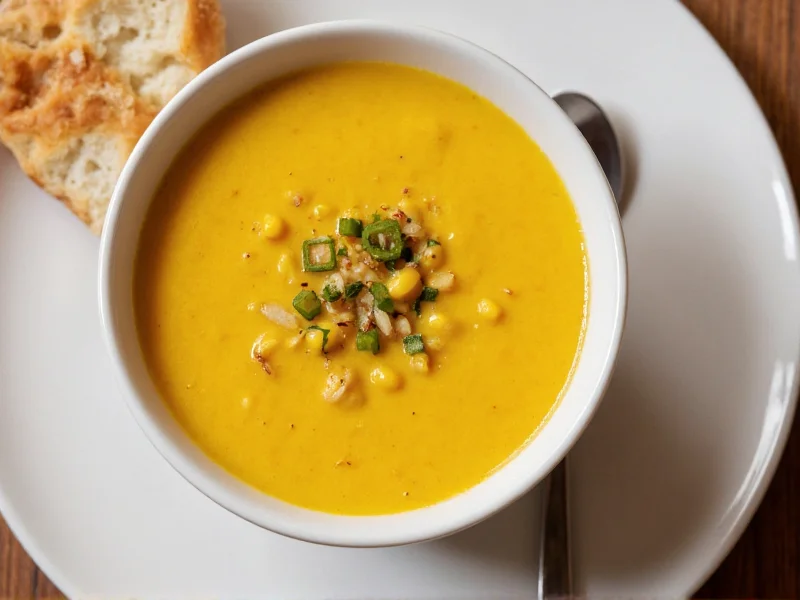Corn soup represents one of the most accessible and satisfying comfort foods across numerous culinary traditions. This humble dish transforms sweet corn kernels into a nourishing meal through straightforward cooking techniques that preserve corn's natural sweetness while developing complex flavors. The foundation of excellent corn soup lies in understanding how to maximize corn's flavor potential whether using fresh, frozen, or canned varieties.
The Rich History of Corn Soup
Corn soup's origins trace back to indigenous American cultures who first cultivated maize thousands of years ago. Native American tribes developed early versions of corn soup using stone-ground corn, water, and available seasonal ingredients. When European settlers arrived, they adopted and adapted these recipes, incorporating dairy and other Old World ingredients. Today, corn soup appears in culinary traditions worldwide, from Mexican crema de elote to Chinese corn soup with egg drop variations.
Popular Corn Soup Variations
Different culinary traditions have created distinctive corn soup interpretations:
| Variation | Key Characteristics | Preparation Time |
|---|---|---|
| Cream Corn Soup | Rich texture from dairy or coconut milk, sweet corn flavor prominent | 25 minutes |
| Chicken Corn Soup | Shredded chicken, vegetable broth base, often with carrots and celery | 35 minutes |
| Vegetarian Corn Chowder | Hearty with potatoes, bell peppers, and corn kernels | 30 minutes |
| Mexican Esquites Soup | Spicy with chili powder, lime, and cotija cheese | 20 minutes |
Essential Ingredients for Perfect Corn Soup
The quality of your corn determines your soup's success. Fresh corn provides the sweetest flavor during summer months, while frozen corn offers consistent quality year-round. Canned corn works in a pinch but often lacks the bright flavor of other options. For how to make creamy corn soup from scratch, you'll need:
- 4 cups corn kernels (about 6-8 ears fresh corn)
- 1 medium onion, finely diced
- 2 cloves garlic, minced
- 3 cups vegetable or chicken broth
- 1 cup milk or cream (or coconut milk for dairy-free)
- 2 tablespoons butter or olive oil
- Salt, pepper, and fresh herbs to taste
Step-by-Step Preparation Guide
Follow these steps for the best ingredients for homemade corn soup that maintains perfect texture and flavor balance:
- Sauté onions in butter over medium heat until translucent (5 minutes)
- Add garlic and cook for 1 minute until fragrant
- Stir in half the corn kernels and cook for 3 minutes to enhance sweetness
- Pour in broth and bring to a gentle simmer
- Blend the mixture until smooth for creamy texture (optional)
- Return to pot and add remaining corn kernels for texture
- Stir in milk or cream and heat through without boiling
- Season with salt, pepper, and fresh herbs like thyme or chives
This easy corn soup recipe for beginners creates a velvety base while preserving some whole kernels for textural contrast. For thicker soup, blend more of the corn; for brothier soup, add additional broth.
Nutritional Benefits of Corn Soup
Corn provides valuable nutrients including fiber, vitamin B, and antioxidants like lutein. A standard serving (1 cup) of homemade corn soup typically contains:
- Approximately 150-200 calories (varies with added dairy)
- 4-6 grams of dietary fiber
- Significant vitamin C and B vitamins
- Good source of magnesium and potassium
- Natural antioxidants that support eye health
For healthy vegetarian corn soup variations, substitute dairy with coconut milk and use vegetable broth. Adding beans or lentils boosts protein content while maintaining the soup's comforting nature.
Serving Suggestions and Storage Tips
Serve corn soup hot with complementary elements that enhance its natural sweetness:
- Garnish with fresh chives, cilantro, or a drizzle of cream
- Pair with crusty bread or cornbread for dipping
- Add crumbled bacon or shredded chicken for protein
- Top with toasted pumpkin seeds for crunch
Properly stored in an airtight container, corn soup keeps for 3-4 days in the refrigerator. For longer storage, freeze portions for up to 3 months. When reheating, add a splash of broth or milk to restore ideal consistency. Avoid boiling when reheating to preserve flavor and texture.
Common Corn Soup Mistakes to Avoid
Even traditional corn soup cooking techniques can go wrong without proper attention to detail. Avoid these common pitfalls:
- Overcooking the corn, which diminishes its sweet flavor
- Using excessive thickeners that mask corn's natural taste
- Adding dairy at too high a temperature, causing curdling
- Skipping the step of sautéing some corn before adding liquid
- Over-blending, resulting in a textureless puree
For optimal results in your corn soup nutritional benefits and facts preparation, taste frequently during cooking and adjust seasoning gradually. Remember that corn's natural sweetness means you rarely need additional sugar.
Perfecting Your Corn Soup Consistency
Achieving perfect corn soup consistency tips requires understanding how different elements affect texture:
- For creamier texture: Blend 75% of the soup and leave 25% whole
- For thicker soup: Simmer uncovered to reduce liquid
- For thinner broth: Add additional warm broth gradually
- To prevent separation: Temper dairy by slowly adding hot soup before incorporating
- For restaurant-quality finish: Finish with a small pat of butter for sheen
Mastering these techniques ensures your corn soup storage and reheating instructions will yield consistently excellent results whether serving immediately or enjoying leftovers.











 浙公网安备
33010002000092号
浙公网安备
33010002000092号 浙B2-20120091-4
浙B2-20120091-4